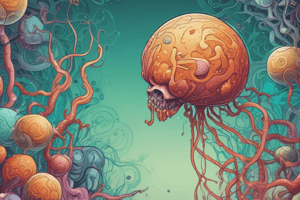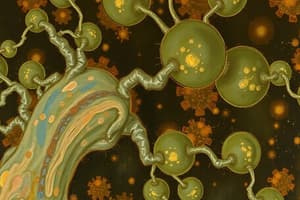Podcast
Questions and Answers
What is the primary role of fever in the immune response?
What is the primary role of fever in the immune response?
- To enhance the immune response by speeding up metabolism and phagocyte activity (correct)
- To promote the activation of B cells
- To inhibit the production of cytokines
- To directly kill pathogens through temperature increase
Which immune response mechanism is primarily involved in dealing with intracellular bacteria?
Which immune response mechanism is primarily involved in dealing with intracellular bacteria?
- Inhibition of surface antigen variability
- Phagocytosis and killing in the phagolysosome (correct)
- Activation of complement
- Neutralization by antibodies
What characterizes the adaptive immune response against extracellular bacteria?
What characterizes the adaptive immune response against extracellular bacteria?
- Release of eosinophils and IgE production
- Type I interferons and NK cell activation
- Phagocytosis and T cell activation
- Neutralization by antibodies and complement activation (correct)
Which aspect of the immune response is primarily promoted by the complement system?
Which aspect of the immune response is primarily promoted by the complement system?
Which immune response primarily addresses fungal infections?
Which immune response primarily addresses fungal infections?
What mechanism do viruses employ to evade the host immune response?
What mechanism do viruses employ to evade the host immune response?
What defines a pathogen as opposed to normal flora in host-microbe interactions?
What defines a pathogen as opposed to normal flora in host-microbe interactions?
Which type of microorganism is characterized by being obligate parasites that cannot replicate outside host cells?
Which type of microorganism is characterized by being obligate parasites that cannot replicate outside host cells?
Which of the following is NOT a recognized type of pathogen affecting human hosts?
Which of the following is NOT a recognized type of pathogen affecting human hosts?
What may result from an asymptomatic carrier status in host-microbe interactions?
What may result from an asymptomatic carrier status in host-microbe interactions?
Which component is considered part of the host's innate immunity?
Which component is considered part of the host's innate immunity?
What is the role of phagocytosis in the host's defense against pathogens?
What is the role of phagocytosis in the host's defense against pathogens?
Which of the following pathogens typically has a complex life cycle?
Which of the following pathogens typically has a complex life cycle?
How do pathogens commonly invade host tissues?
How do pathogens commonly invade host tissues?
What is a primary characteristic of helminths as pathogens?
What is a primary characteristic of helminths as pathogens?
What role do pathogen associated molecular patterns (PAMP) play in the immune system?
What role do pathogen associated molecular patterns (PAMP) play in the immune system?
What is the main function of the surface barriers in the immune system?
What is the main function of the surface barriers in the immune system?
Which of the following components is considered a part of innate immunity?
Which of the following components is considered a part of innate immunity?
Which statement accurately reflects adaptive immunity?
Which statement accurately reflects adaptive immunity?
What are antigenic epitopes recognized by?
What are antigenic epitopes recognized by?
Which type of immunity is primarily activated by the presence of antigens?
Which type of immunity is primarily activated by the presence of antigens?
What is the significance of commensal microbiota in immune defense?
What is the significance of commensal microbiota in immune defense?
Which immune response mechanism is characterized by its ability to specifically target and remember pathogens?
Which immune response mechanism is characterized by its ability to specifically target and remember pathogens?
What can lead to opportunistic infections in a host?
What can lead to opportunistic infections in a host?
What is the primary purpose of immune suppression in the context of pathogens?
What is the primary purpose of immune suppression in the context of pathogens?
Prions are small, proteinaceous infectious particles that contain a nucleic acid genome.
Prions are small, proteinaceous infectious particles that contain a nucleic acid genome.
Viruses can replicate independently outside of host cells.
Viruses can replicate independently outside of host cells.
The immune system consists of barriers that include physical, chemical, and biological defenses.
The immune system consists of barriers that include physical, chemical, and biological defenses.
Helminths are characterized as single-celled prokaryotic organisms.
Helminths are characterized as single-celled prokaryotic organisms.
Asymptomatic carriage refers to a pathogen that remains active and causes noticeable symptoms in the host.
Asymptomatic carriage refers to a pathogen that remains active and causes noticeable symptoms in the host.
Pathogen associated molecular patterns (PAMP) are unique to each individual pathogen and do not interact with host recognition molecules.
Pathogen associated molecular patterns (PAMP) are unique to each individual pathogen and do not interact with host recognition molecules.
Adaptive immunity includes both B cells and T cells, which play critical roles in responding to specific antigens.
Adaptive immunity includes both B cells and T cells, which play critical roles in responding to specific antigens.
The three lines of defense in the immune system include only biological barriers.
The three lines of defense in the immune system include only biological barriers.
Normal flora in the body can help protect against colonization by pathogens through competition and production of toxic components.
Normal flora in the body can help protect against colonization by pathogens through competition and production of toxic components.
The innate immune response is characterized by its ability to recognize specific pathogens and develop long-lasting immunity.
The innate immune response is characterized by its ability to recognize specific pathogens and develop long-lasting immunity.
Cytokines play a crucial role in mediating communication between immune cells during an immune response.
Cytokines play a crucial role in mediating communication between immune cells during an immune response.
Antigens are substances that do not activate immune responses in the body.
Antigens are substances that do not activate immune responses in the body.
Virulence factors are essential for the survival of pathogens in the environment but not necessary for infection.
Virulence factors are essential for the survival of pathogens in the environment but not necessary for infection.
Memory in adaptive immunity allows for a faster and more effective response upon subsequent exposures to the same antigen.
Memory in adaptive immunity allows for a faster and more effective response upon subsequent exposures to the same antigen.
Surface barriers such as intact skin and mucosa act as a first line of defense against invading pathogens by keeping them outside host tissues.
Surface barriers such as intact skin and mucosa act as a first line of defense against invading pathogens by keeping them outside host tissues.
Flashcards
Host-microbe interaction
Host-microbe interaction
The relationship between a human body and microorganisms, including beneficial (normal flora) and harmful (pathogens).
Pathogens
Pathogens
Microbes that cause host damage through direct actions or immune response.
Normal flora
Normal flora
Microbes that live in specific areas of the body in a stable way and benefit the host.
Bacteria
Bacteria
Signup and view all the flashcards
Viruses
Viruses
Signup and view all the flashcards
Immune system
Immune system
Signup and view all the flashcards
Innate immunity
Innate immunity
Signup and view all the flashcards
Contagious potential
Contagious potential
Signup and view all the flashcards
Host defenses
Host defenses
Signup and view all the flashcards
Innate Immune Response
Innate Immune Response
Signup and view all the flashcards
Complement System
Complement System
Signup and view all the flashcards
Phagocytes
Phagocytes
Signup and view all the flashcards
Adaptive Immunity vs. Innate Immunity
Adaptive Immunity vs. Innate Immunity
Signup and view all the flashcards
Extracellular Bacteria
Extracellular Bacteria
Signup and view all the flashcards
CTL (Cytotoxic T Lymphocytes)
CTL (Cytotoxic T Lymphocytes)
Signup and view all the flashcards
Antigen
Antigen
Signup and view all the flashcards
Adaptive immunity
Adaptive immunity
Signup and view all the flashcards
Pathogen associated molecular patterns (PAMPs)
Pathogen associated molecular patterns (PAMPs)
Signup and view all the flashcards
Surface barriers
Surface barriers
Signup and view all the flashcards
Physical Barriers
Physical Barriers
Signup and view all the flashcards
Chemical Barriers
Chemical Barriers
Signup and view all the flashcards
Cytokines
Cytokines
Signup and view all the flashcards
NK Cells (Natural Killer cells)
NK Cells (Natural Killer cells)
Signup and view all the flashcards
Antigen-presenting cells
Antigen-presenting cells
Signup and view all the flashcards
Types of Pathogens
Types of Pathogens
Signup and view all the flashcards
Outcomes of Infection
Outcomes of Infection
Signup and view all the flashcards
Host Defense: Barriers
Host Defense: Barriers
Signup and view all the flashcards
Host Defense: Immune System
Host Defense: Immune System
Signup and view all the flashcards
Virulence Factors
Virulence Factors
Signup and view all the flashcards
Immune Suppression
Immune Suppression
Signup and view all the flashcards
Drug Resistance
Drug Resistance
Signup and view all the flashcards
Pathogen-Associated Antigens
Pathogen-Associated Antigens
Signup and view all the flashcards
PAMPs
PAMPs
Signup and view all the flashcards
Antigenic Epitope
Antigenic Epitope
Signup and view all the flashcards
Three Lines of Defense
Three Lines of Defense
Signup and view all the flashcards
Adaptive Immunity: Memory
Adaptive Immunity: Memory
Signup and view all the flashcards
Study Notes
Host-Pathogen Interactions
- The human body is constantly interacting with various microorganisms.
- Some microorganisms are normal flora/microbiota, peacefully coexisting with the host for mutual benefit.
- Other microorganisms are pathogens, capable of causing host damage via direct microbial action or inappropriate immune response.
Types of Host-Microbe Relationships
- Commensalism: One organism benefits, the other is neither harmed nor benefited.
- Parasitism: One organism benefits at the expense of the other.
- Mutualism: Both organisms benefit.
Pathogens Affecting Human Hosts
- Bacteria: Prokaryotic, single-celled organisms with a single DNA chromosome and cell walls (e.g., E. coli).
- Viruses: Smaller than bacteria, with DNA or RNA genomes; obligate parasites needing host cells to replicate (e.g., CMV, HIV).
- Protozoa: Single-celled eukaryotic organisms with organelles and simple or complex life cycles (e.g., P. falciparum, leishmania).
- Helminths: Multicellular organisms, often worms, with simple or complex life cycles (e.g., A. lumbricoides).
- Fungi: Eukaryotes with cell walls containing chitin or cellulose, and form spores (e.g., C. albicans).
- Arthropods: Organisms with jointed appendages; commonly ectoparasites (e.g., S. scabiei).
- Prions: Small proteinaceous infectious particles without nucleic acid genomes (e.g., in CJD or BSE).
Pathogen Size Comparison
- Images show pathogens and their comparative sizes (from meters to nanometers) relative to the naked eye, light microscope, and electron microscope.
Types of Transmission and Their Control
- Respiratory or salivary spreads (aerosols, saliva) are difficult to control.
- Fecal-oral spread is controllable with public health measures.
- Venereal spread is difficult to control due to social factors.
- Arthropod-borne infections and zoonoses (e.g., malaria, typhus, plague) involve vectors and vertebrate reservoirs for transmission.
Outcome of Infectious Process
- Eviction: Pathogen elimination.
- Asymptomatic carriage: Pathogen contained in the host, potentially leading to latent or carrier status.
- Clinical disease: Symptoms following incubation period (acute or chronic).
Pathogen (Invader) and Host (Defender)
- Pathogen (Invader): Bacteria, viruses, parasites, fungi causing host damage and disease.
- Contagious potential (inoculum size, transmission, entry, adherence, tissue invasion)
- Virulence factors and pathogenicity (direct or indirect effects).
- Evasion mechanisms to host immunity.
- Acquisition of drug resistance capacity.
- Host (Defender): Immune system (organs, cells, soluble factors).
- Physical, chemical, and biological barriers.
- Innate (general) immunity.
- Adaptive (specific) immunity.
- Immune suppression may lead to opportunistic infections.
Pathogen-Associated Antigens
- Antigens trigger immune responses.
- Innate immunity, antibody formation, and T-cell-mediated immunity are activated in response to antigens.
- Pathogen-associated molecular patterns (PAMPs).
- Molecules found on pathogens that activate innate immune receptors (PRRs).
- Pathogen-associated specific antigen epitope (antigenic determinant).
- Part of an antigen recognized by adaptive T and B cells receptors.
Organs of the Immune System
- Immune system is located in various organs.
- Primary organs for immune cell development are bone marrow and thymus.
- Secondary organs for immune responses are elsewhere (e.g., spleen).
Lymphatic Circulation
- Lymphatic system functions in fluid transport and immune responses.
Cells of the Immune System
- Key immune cells (e.g., phagocytes, lymphocytes, natural killer cells) are listed with functions.
Specific Immune Cells with Functions
- Macrophage: Presenting antigens to helper T cells, producing cytokines (chemicals involved in cellular communication).
- Neutrophil: Phagocytosis (engulfing pathogens).
- Eosinophil: Kills parasites.
- Basophil: Inflammation.
- Mast cell: Inflammation and allergies.
- Dendritic cell: Presenting antigens to T cells.
Lymphocytes
- Key role in adaptive immune responses.
- B cells: Recognize antigens via membrane-bound antibodies; produce antibodies.
- T cells: Coordinate immune responses and kill infected/abnormal cells.
- Natural killer cells (NK cells): Kill stressed/unhealthy cells.
Soluble Factors
- Complement: Direct cell lysis (breaking down cells), enhancement of lymphocyte responses.
- Cytokines: Cell-to-cell/tissue communication and various immune responses (e.g., inflammation, antibody production, cell growth/differentiation).
- Interleukins: Various immune functions (inflammation and differentiation).
- Interferons: Resistance to viral infections.
- TNFs: Inflammation and tumor cell destruction.
- Other chemicals: Various biochemical activities (e.g., antimicrobial actions).
Three Lines of Defense
- Physical, chemical, and biological barriers: Preventing pathogen entry.
- Innate immunity: General response to destroy pathogens before they establish themselves.
- Adaptive immunity: Specific response targeting and remembering particular pathogens.
Surface Barriers
- Physical barriers (intact skin).
- Chemical barriers (secretions like saliva, tears, acidic environment).
- Biological barriers (normal flora/microbiota).
Innate Immunity
- Non-specific immune mechanisms targeting pathogen elimination.
- Binding of PRRs (Toll-like receptors) to PAMPs triggers immediate defense responses.
- Key processes: fever, inflammation, phagocytosis, complement activation, natural killer cells.
Inflammation
- Response to tissue damage or infection.
- Involves chemical signals, blood vessel changes, and immune cell migration to eliminate pathogens.
Phagocytes
- Cells engulf and destroy pathogens/particles.
- Key steps include chemotaxis and adherence, ingestion, phagosome formation, phagolysosome formation and digestion, residue removal.
Complement
- Part of the innate immune system that enhances other immune responses.
- Facilitates pathogen clearance, inflammation, and cell lysis (breaking down cells).
Adaptive Immunity
- Specific and targeted response tailored to specific pathogens encountered throughout life.
- Key features: specificity, memory, and diversity.
Adaptive Immunity, cont.
- B and T cells recognize and bind to specific antigens, divide by mitosis.
- Descendent cells recognize the same antigen.
- T cells only recognize antigen presented by antigen-presenting cells (APC).
- APC digest particles and display antigen in MHC complexes.
Cell-Mediated Immunity (Cellular Immunity)
- Processes like antigen "presenting" by macrophages to T cells activate immune responses.
- Cytotoxic T cells kill infected/abnormal cells and coordinate helper T cell activity.
Antibody-Mediated Immunity (Humoral Immunity)
- Antibodies bind to antigens, facilitating phagocytosis, complement activation/lysis, and neutralizing pathogens.
Adaptive Immunity, cont.
- Differentiated lymphocytes (B and T cells) initiate immediate responses to fight infection.
- B cells produce antibodies targeting specific antigens in bodily fluids; activate complement and phagocytosis or neutralize pathogens.
- Cytotoxic T cells kill infected or abnormal cells.
- Memory cells persist to provide a faster and stronger response to future encounters with familiar antigens.
Primary and Secondary B Cell Responses
- Primary response to first exposure produces effector and memory B cells.
- Secondary response triggered by subsequent exposures is stronger and faster due to memory cells.
Innate and Adaptive Immunity Comparison
- Innate: Immediate response, non-specific.
- Adaptive: Delayed response, specific.
Nature of Invader Determines Host Immune Response
- The type of pathogen dictates how the body responds immunologically. Different pathogens trigger different immune responses.
Pathogen Evasion Mechanisms
- Pathogens employ various mechanisms to evade the host's immune responses (e.g., antigenic variation, complement inhibition, evasion of phagocytosis).
Environment: Source & Reservoir
- Source: Site where a pathogen is transmitted.
- Reservoir: Site where pathogens multiply.
- Examples like humans, animals, food, water.
- Yellow fever with monkeys as a reservoir, mosquitos as a source.
Studying That Suits You
Use AI to generate personalized quizzes and flashcards to suit your learning preferences.





